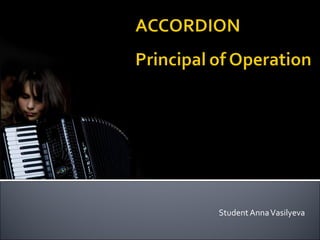Anna Vasilyeva, "ACCORDION - Principal of Operation"
- 2. Art is born at the junction of Sciences
- 3. Bellows Body: right-hand manuals left-hand manuals
- 4. ŌĆ” the SOUL of accordion
- 5. Clear tones without resonance Volume control Bellows shaking Accent Natural sounds
- 6. ╠²
- 7. Body: Right-hand different keyboards and registers Left-hand Standard-bass system ( bass + accord ) Free-bass system
- 8. The accordion is an aerophone.
- 9. ╠²
- 10. Thank you for your attention!
Editor's Notes
- #3: There is a very well-known view that art is born at the junction of Sciences. Today we will talk about the greatness of engineering idea and music. As a result of their interaction we can see the creation of very interest musical instrument. You are seeing it in my hands. People names it an accordion. LetŌĆÖs remember how it soundsŌĆ”
- #4: LetŌĆÖs consider the construction of this instrument. There are a lot of different configurations and types of accordions. What may be technically possible to do with one accordion could be impossible with another. But all of them have universal components, such as bellows and body. The accordion's body consists of two wood boxes joined together by a bellows. These boxes house reed chambers for the right- and left-hand manuals, respectively.
- #5: The bellows is the most recognizable part of my instrument. Musicians name it ŌĆō the soul of accordion. ItŌĆÖs the main part of an accordion because without it ŌĆō you canŌĆÖt hear any sound. LetŌĆÖs try. Similar to a violin's bow, the production of sound in the accordion is in direct proportion to the motion of the player. It is located between the right- and left-hand manuals. It is used to create pressure and vacuum, driving air across the internal reeds and producing sound by their vibration, applied pressure increasing the volume.
- #6: The keyboard touch is not very expressive and does not affect dynamics: all expression is effected through the bellows. I try to show you some of them: some bellows effects as illustrated below: Bellows used for volume control/fade Repeated change of direction ("bellows shake") Constant bellows motion while applying pressure at intervals Constant bellows motion to produce clear tones with no resonance Using the bellows with the silent air button gives the sound of air moving, which is sometimes used in contemporary compositions particularly for this instrument
- #7: Bellows are made from pleated layers of cloth and cardboard, with added leather and metal.
- #8: The accordion's body consists of two wood boxes joined together by a bellows. These boxes house reed chambers for the right- and left-hand manuals, respectively. The grille is necessarily to protect my instrument from the dust. LetŌĆÖs remove one of them. In the right-hand you see the piano key-board, but the shapes are not so wide as in piano ŌĆō so I can take more shapes in one moving. There are different keyboards on the Earth ŌĆō IŌĆÖm playing piano and KravtsovŌĆÖs. I think that youŌĆÖve noticed the buttons near the keyboard. There are registers. I use them to change the character of sounds (tembre) and the number of voices in one time. Look, now I want to play as a fleut. Are you hearing?) And now ŌĆō as a fagot And now I want to be as a big orchestra ) The left hand the same picture, but with adding of another system. Free-bass and stradella ŌĆō what does it mean? My instrument are playing ŌĆō because the grille is not the functional part of accordion. Left-hand manual has 2 different systems: Free-bass and stradella. The first system gives the name to accordion. It was a big discover then somebody invent that he can push only one button and listen for 3 sounds in one time ŌĆō He hear the accord. The second system was invented not far from this day. It allows to play classic music on accordion, because it Each side has grilles in order to facilitate the transmission of air in and out of the instrument, and to allow the sound to better project. The grille for the right-hand manual is usually larger and is often shaped for decorative purposes. The right-hand manual is normally used for playing the melody and the left-hand manual for playing the accompaniment, however skilled players can reverse these roles . The size and weight of an accordion varies depending on its type, layout and playing range, which can be as small as to have only one or two rows of basses and a single octave on the right-hand manual, to the standard 120-bass accordion and through to large and heavy 160-bass free-bass converter models.
- #9: Now I want to open you the main secret of accordion. Many people think that the accordion and an organ are the similar instruments with similar principal of sound creation. This is the great mistake. To produce the sound organ also uses the bellows, but after this the air goes thought the different pipes from metal and wood. The creation sound in piano you have just known from AlekseyŌĆÖs presentation ŌĆō it use ą║ą╗ą░ą▓ąĖčłąĄ-čāą┤ą░čĆąĮčŗą╣ ą╝ąĄčģą░ąĮąĖąĘą╝.
- #10: An illustration of the pallet mechanism in Piano Accordions. As the key is pressed down the pallet is lifted, allowing for air to enter the tone chamber in either direction and excite the reeds; air flow direction depends on the direction of bellows movement. Note that this is a side view of a piano accordion keyboard, so a similar effective mechanical pallet movement is used for buttons, both on button accordions and bass mechanisms, including the Stradella









